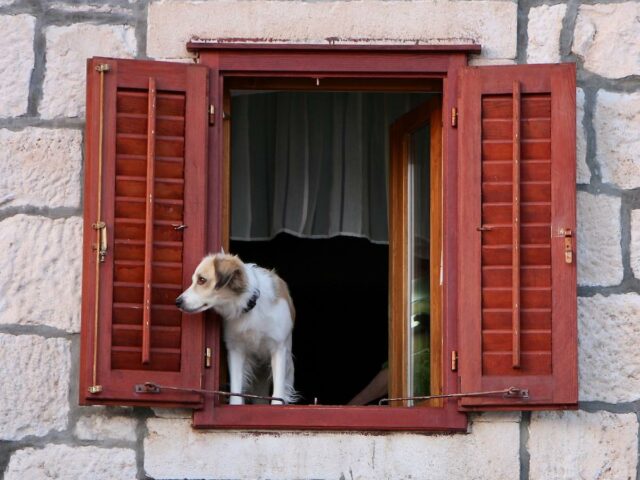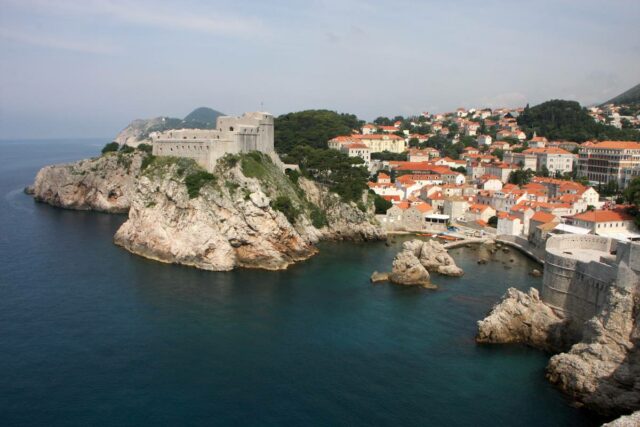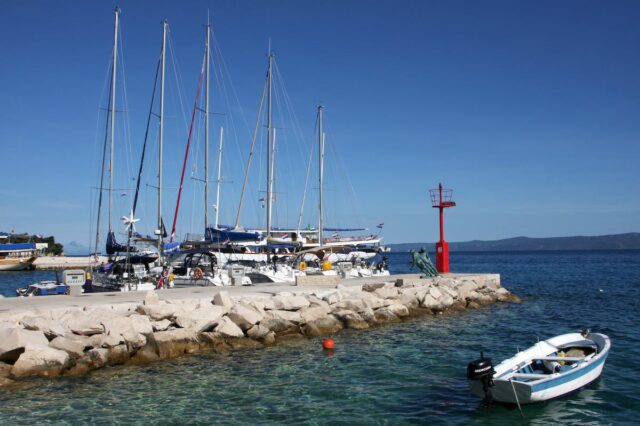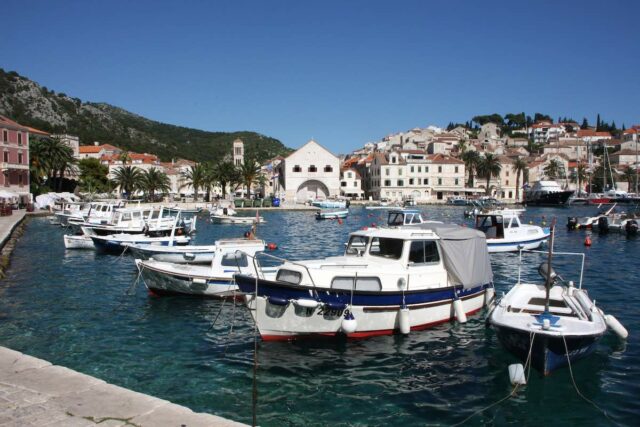Croatia is a popular European destination in summer, thanks to its long coastline and string of islands in the Adriatic Sea. Back in 2012 I spent a wonderful week sailing along the coast, back when it was becoming popular but still affordable. These days, make sure you book well in advance for the peak summer season, plus be prepared for crowds and high prices.
But what’s it like to visit Croatia with a dog? Unfortunately, Croatia is one European country that I wish I had spent more time in with my dog. After running out of time for more than a quick visit, we had planned to return in 2020 or 2021, but like those of many people, our travel plans were upended.
However, based on our brief visit, tips from friends and the notes I put together for our longer trip that didn’t eventuate, I’ve put together this guide on visiting Croatia with a dog. I hope you find this useful!

Travelling to Croatia with a Dog
Croatia recently joined the Schengen Zone, meaning that you’ll no longer need to show your passport when driving across the border from Slovenia or Hungary.
But for many years it’s been quite simple to visit Croatia with a dog from other EU countries – your dog just needs to be microchipped, have a valid rabies vaccine and a pet passport. (And our dog’s passport wasn’t even checked when driving across from Slovenia.)
The rules are slightly more complicated when entering Croatia with a dog from Serbia, Bosnia and Herzegovina or Montenegro, all non-EU countries. In particular, a rabies titre test is required when entering the EU from Serbia and Montenegro.
For more details, including a discussion of whether paperwork is really checked, see my guide to travelling into the EU with a dog from other European countries. Also check in advance the entry points where your dog’s paperwork can be checked. (Some border crossings are just for locals.)
Dining out in Croatia with a Dog
When I visited Croatia with my dog on a brief trip, the weather was still warm and we dined at an outdoor terrace, a very common option during the summer months.
Which was just as well, because according to dog owners who have spent more time in the country, dining indoors with your dog is not really a thing in Croatia. You may get lucky with some friendly cafe owners, but it’s easiest to stick to outdoor dining areas only.

Taking a Dog on Public Transport in Croatia
Croatia is served by a mix of public transport, including a small train system, an extensive network of buses and the many ferries to the islands off the coast. The rules for dogs on public transport vary depending on the option.
Are Dogs Allowed on Trains in Croatia?
Both small and large dogs are allowed to accompany you on trains in Croatia. For small dogs, defined as being up to 30cm high, they can travel in a travel crate or on your lap, with no fee required.
For larger dogs, the rules are more extensive. It’s a must that they travel with their veterinary booklet (such as an EU pet passport), showing their microchip number and vaccination history. They need to wear a short leash and a muzzle. A half-price 2nd class ticket is required for your dog, to be bought at the station.
Note that each passenger can only bring a single dog or pet travel crate onboard. Plus, if you’re travelling in a sleeping coach, you need to reserve the entire section. Dogs are not allowed in dining coaches.
Unfortunately, though, the train network in Croatia is not that extensive.

Are Dogs Allowed on Buses in Croatia?
The bus network in Croatia is far more extensive, and will take you to many places not covered by the train network. However, buses in Croatia are not as dog-friendly.
I’ve heard from other dog owners visiting Croatia that it’s up to the individual bus driver whether you are allowed onboard with your dog – you need to be flexible! Plus, only small dogs in a carrier are likely to be accepted.
On buses replacing trains, the train company website states that only small pets in a transport box are allowed onboard, not larger dogs.
Are Dogs Allowed on Ferries in Croatia?
Thankfully, it’s a lot easier to travel on ferries in Croatia with a dog, with most ferries allowing pets onboard with no last minute approvals required!
Each ferry company has their own pet policy, but the rules are usually roughly the same. For example, when travelling on the ferries operated by MB Kapetan Luka – Krilo, their FAQ has a long list of rules for pets:
- Pets must not be a danger or nuisance to other passengers
- Small pets can travel inside the saloon in a soft travel bag up to 45 x 35 x 25cm, under the seat or on your lap. There is a limit of one pet travel bag per passenger. A 50% fare is charged.
- Larger dogs need to be muzzled and leashed, and can only board if there are special boxes (kennels) on the outside deck. A 100% fare is charged.
Double check the relevant rules in advance, plus whether kennel facilities are available if you are travelling with a larger dog. Generally these are only available on the slower ferries, not the high-speed catamarans. Fares are not always charged for dogs.
Click to view the rules for pets onboard Jardolinija and TP Line.
Dog-Friendly Accommodation in Croatia
When travelling with a dog in Croatia, it’s probably best to stay in private rentals and Airbnbs, rather than hotels. When I investigated the percentage of European hotels allowing pets, only 13% of hotels in Dubrovnik were pet-friendly, although maybe more hotels are pet-friendly elsewhere.
If looking for holiday apartments, it’s often worthwhile asking the owners directly if they will permit your pet, especially if they are small or you have many good reviews from past Airbnb stays – often they will be more flexible, particularly outside of the peak summer season.
Dog-Friendly Sightseeing in Croatia
There’s plenty of things to see in Croatia when visiting with your dog. In particular, tick some of these dog-friendly attractions off during your visit.
#1 Walk Along the Walls of Dubrovnik
The southern town of Dubrovnik is one of the most popular tourist destinations in Croatia, thanks to its beautiful Old Town and its use as a location in the TV series, Game of Thrones.

To get the best views of the Old Town, it’s a must to wander along the walls of the Old Town. Stretching for almost 2km in length and up to 6m wide in places, the walls and towers enable you to look down into the steep, narrow streets of the town, without the chance of getting lost. On the seaward side, gaze into the beautiful blue waters that surround the town.
During the summer months it’s best to do the walk early or late in the day, both to avoid the heat of the day and the cruise ship loads of tourists. Entrance to the Walls of Dubrovnik is these days quite expensive (and rising each year). Consider buying a 1-Day Dubrovnik Card if you’re interested in visiting other historical sites for only slightly more.

Luckily, pet dogs are welcome to join you on the walls, for no charge. (Although they’re likely to not be allowed at the other historical sites.) The one requirement is to keep your dog on a leash – a short leash is a must, especially along the sections where only a railing separates you and your dog from a tall drop.
#2 Spot the Remains of the Palace of Diocletian
One of the other UNESCO-listed World Heritage Sites in Croatia is the city of Split, including the ruins of the Palace of Diocletian, built long ago between the late 3rd and early 4th centuries.
When I visited Split, I found it quite confusing, because there is no stand-alone palace or archaeological site to see. Instead, the ruins of the palace can be found scattered through the streets of the city, incorporated into newer buildings.
Go through a wander through Split with your pup and see what you can spot. (There’s also historic churches, medieval fortifications and more recent palaces.) Afterwards, I recommend strolling along the waterfront, perhaps stopping at one of the many cafes or enjoying a gelato while you walk.

#3 Go Island Hopping
When I visited Croatia in 2012, I joined a sailing tour, visiting multiple islands along the coast in between Dubrovnik and Split. While dogs are generally not allowed on organised sailing tours and not everyone is up to sailing their own yacht (myself included!), it’s still easy to access the many islands via ferry.

As I discussed above, dogs are generally allowed on ferries in Croatia, although some of the high-speed ferries may not allow larger dogs that cannot fit in a carrier bag. Luckily then there’s plenty of ferries to choose from, particularly during the warmer months of the year.
One of the easiest Croatian islands to visit is Hvar, just a 2 hour ferry trip from Split. A range of ferries operate to Hvar, including car ferries. Note that some ferries travel directly to the Old Town of Hvar, while others head to Stari Grad, on the northern side of the island.

#4 Explore the Lesser Known Towns in Croatia
While Dubrovnik and Split are two of the most popular tourist destinations in Croatia, there are also dozens of lesser known towns scattered along the coastline that are still a delight to visit, but without being so crowded, especially if you visit during the shoulder season.
The town of Opatija on the Kvarner Gulf has been a fashionable resort town since the 19th century, but remains small and surrounded by nature. Check out this guest post on dog-friendly Opatija written by a Croatian local.
I also recommend visiting the Puna Peninsula in the north of Croatia. There’s plenty of smaller seaside towns, and it’s just a short drive from Slovenia or Italy. We enjoyed a delightful day in historic Poreč during early autumn.

#5 Hit the Beach with Your Dog
There’s no need to skip heading to the beach in Croatia when visiting with your dog. Head to Crikvenica in northern Croatia, home to Monty’s Dog Beach and Bar.
Dogs are allowed off-leash at this strip of sand, which is also home to a certified agility park, showers for dogs, dog water bowls and a dog menu. For humans, there’s a range of beach equipment available for rent, a long list of drinks and snacks available. Entry is free, although nearby parking is paid.
Monty’s also operates a second dog beach in Croatia, on the island of Rab, next to a pet-friendly camp.
#6 Visit the Plitvice Lakes
Heading inland in Croatia, another very popular destination are the Plitvice Lakes. Contained within the Nacionalni Park Plitvička Jezera, or Plitviče Lakes National Park, dogs are fine to join you in this national park, as long as they are kept on a leash.
The highlight of a visit to Plitvice Lakes is following the walking trails past the stunning lakes that cascade from one to another. Both one and two-day tickets are available, with the advance purchase of tickets essential during the summer period.
Note that tickets are far more expensive during the peak period (€40 for an adult one-day ticket before 4pm during June, July, August and September, as of 2024). Entry is cheaper after 4pm or during the shoulder months (April, May, October), and drops to a mere €10 for adults between November and March.
Consider visiting out of peak season or later in the day (and staying overnight close by). As well as cheaper entry, the trails will also be far less crowded and more comfortable for walking with your dog!
You May Also Like
About the Author

Shandos Cleaver is the founder of Travelnuity: Dog-Friendly Travel. She has travelled extensively with her Miniature Dachshund, Schnitzel, including to 33 countries across Europe, every state and territory of Australia except Tasmania, and 10 of the United States. She’s passionate about providing inspiration and information to others wanting to travel with their dogs, whether close to home or internationally.
